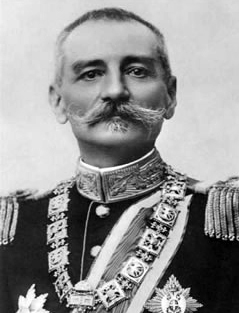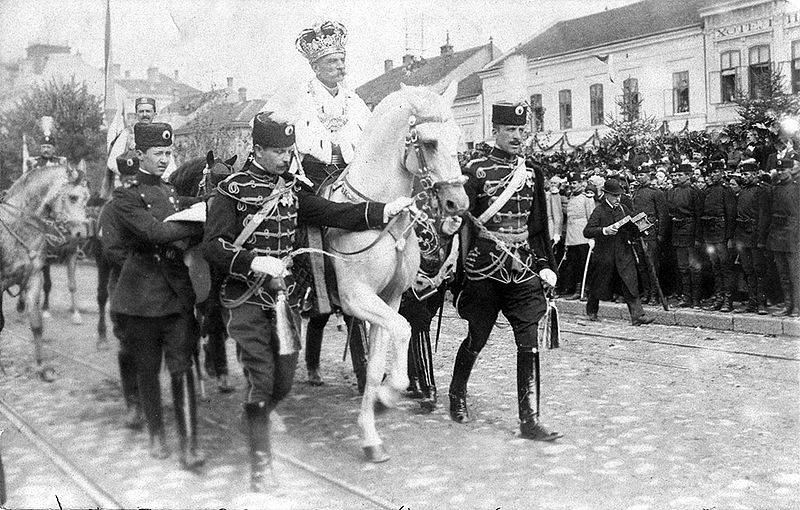<Back to Index>
- King of Serbia Peter I Karađorđević, 1844
PAGE SPONSOR


Peter I (Serbian: Петар I Карађорђевић, Petar I Karađorđević) (29 June 1844 - 16 August 1921), was the last King of Serbia from 1903 to 1918, and subsequently the ruler of the Kingdom of Serbs, Croats and Slovenes (officially renamed Kingdom of Yugoslavia in 1929) from 1918 until his death. He was a member of the Royal House of Karađorđević. As the leader of the victorious Serbian Army in World War I, he received the title of Peter the Liberator (Kralj Petar Oslobodilac) after the war. He is the translator of John Stuart Mill's "On Liberty."
Prince Peter was born in Belgrade to Prince Alexander of Serbia and his consort, Princess Persida Nenadović. Prince Alexander, ruler of Serbia since 1842 abdicated in 1858 and took his son with him into exile in present day Romania.
The young noble spent much of his exile in France, where he received an excellent education at the prestigious École spéciale militaire de Saint - Cyr in Paris. Prince Peter, known to his friends as "Pierre Kara" actively participated in the Franco - Prussian War of 1871 as a volunteer of the Foreign Legion Command, better known as the Legion étrangère. He was very courageous in the battle near Orleans and was wounded. Afterwards he managed to escape the Prussians by swimming across the Loire River.
During the Serb uprising against Ottoman Empire in 1876 in Bosnia and Herzegovina, he took on the name of a seventeenth century Serbian hajduk Petar Mrkonjić of Ragusa, and joined as a leader of the guerilla unit the Bosnian Serb insurgents. He had to leave the region at the insistence of then prince Milan Obrenović, the ruler of Serbia, who saw Prince Peter Karađođević as a rival to the throne of Serbia and feared his popularity among the Serbian people. Prince Peter married Princess Zorka of Montenegro, daughter of King Nicholas I, in 1883. They had five children: Helen in 1884, Milena in 1886, George in 1887, Alexander in 1888 and Andrew in 1890. Milena died at the age of one in 1887, and Andrew, the last child, died in childbirth along with his mother.
After long years in exile in Geneva, Switzerland, where he translated and published Mill's "On Liberty," Prince Peter returned to Serbia in 1903, when a military coup d'état removed King Alexander from the throne. Restorer of democracy and constitutional ruler, Prince Peter was crowned King of Serbia on 21 September 1904 in St. Michael's Cathedral and anointed on 9 October 1904, but reigned from the date of his election in Parliament on 15 June 1903. After 45 years the Karađorđević family regained the leadership of Serbia from the rival House of Obrenović.
The Western educated King attempted to liberalize Serbia with the goal of creating a Western style constitutional monarchy, even translating John Stuart Mill's On Liberty into Serbian.
King Peter I gained enormous popularity following the Balkan Wars which, from a Serb perspective, were a great success, heralded by the liberation of Old Serbia (Vilayet of Kosovo) and Slavic - inhabited Macedonia. After the conflict between military and civilian representatives King Peter chose to "retire" due to ill health, reassigning on 24 June 1914 his royal prerogatives to the Heir apparent Crown Prince Alexander.
The King was relatively inactive during the First World War, although he did occasionally visit trenches to check up on his troops. His visit to the firing line prior to the Battle of Kolubara in late 1914 boosted moral of the retreating Serbian forces and announced a sparkling victory against numerically superior Austro - Hungarian forces. Another memorable visit in 1915 involved King Peter, by then 71, picking up a rifle and shooting at enemy soldiers. Following the invasion of Serbia by the joint forces of Germany, Austro - Hungary and Bulgaria in October 1915, King Peter I led the army and civilian refugees through the mountains of Albania to the Adriatic sea on a 'Calvary known to few peoples'. (R. Wolfson "Years of Change. European History 1890 - 1945").
The rest of the war King Peter spent in Greece, at Corfu, which became a seat of Serbian government in exile until December 1918.
His last public appearance was on 1 December 1918, when he was proclaimed King of the Serbs, Croats and Slovenes. King Peter I died in Belgrade in 1921 at the age of 77. He was solemnly buried in his endowment in Oplenac, the Church of Saint Gorge in the vicinity of Topola where his grandfather Karageorge started the Serbian Revolution against Ottomans in 1804.
As his eldest son, Prince George was King Peter's heir apparent. This changed in 1909, when he kicked a servant to death in a fit of rage, after which the Crown Prince was forced to renounce his claim to the throne in favor of his younger brother Alexander.
King Peter I is remembered for his modesty, attributed to his military background. He was immensely popular throughout his reign and remains one of the Western Balkans's most popular leaders. He is considered to be the founding father of Yugoslavia (this name, colloquial, but very widely used even in European maps during his day, became official in 1929).
His children were influential in European affairs as adults. His son, King Alexander, joined Yugoslavia with the West but forcibly pushed the nascent Yugoslav national identity on his subjects. His daughter, Princess Helen, married Prince Ioann Konstantinovich of Russia who was killed in the Revolution.
There is a modest monument dedicated to King Petar I of Serbia in Orléans, when he fought as a volunteer in the French army. A grand monument to King Petar the Liberator and his son Alexander I of Yugoslavia the Unifier was solemnly inaugurated in 1936, at Porte de la Muette in Paris.
In Paris, an avenue off the Champs - Élysées is named after him, Avenue Pierre 1er de Serbie.